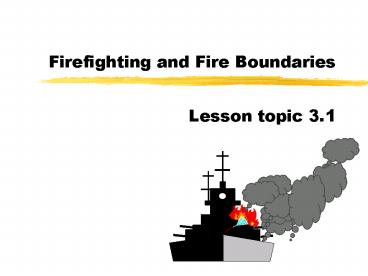Firefighting and Fire Boundaries - PowerPoint PPT Presentation
1 / 16
Title:
Firefighting and Fire Boundaries
Description:
On-Scene Leader is restricted in being able to see the overall picture ... Divisions are responsible for securing the X-ray and Yoke fittings ... – PowerPoint PPT presentation
Number of Views:62
Avg rating:3.0/5.0
Title: Firefighting and Fire Boundaries
1
Firefighting and Fire Boundaries
- Lesson topic 3.1
2
Enabling Objectives
- Coordinate the activities of the damage control
teams of the repair stations - Establish primary and secondary forward and aft
smoke boundaries - Given a damage control scenario record damage
control messages - Record casualties on isometric damage control
diagrams
3
Planning and preparation
- Organization
- Assignments should be made carefully
- Assignments should be specific
- Standard and supplemental organization charts
should be clearly displayed - Review assignments regularly
4
Planning and preparation
- Training
- Repair Party personnel must be thoroughly
indoctrinated and trained in the use of repair
locker equipment - Utilization of PQS, frequent well planned drills,
will contribute to teamwork and minimize
confusion when an actual fire occurs - Cross-training
5
Procedures for Isolating, Confining, Combating,
and Controlling Fires
- Locating and isolating the fire
- Rapid and accurate investigation
- Widespread smoke and multiple fires, must be
expected, during battle damage - Fires and damage must be pinpointed
- Investigators must report promptly
6
Procedures for Isolating, Confining, Combating,
and Controlling Fires
- Initial response to isolate and contain the fire
- Dispatch the On-Scene Leader fire teams
- Commence plotting
- Primary and secondary fire boundaries
- Identify special hazards
- Primary fire boundaries will be set on all six
sides
7
Procedures for Isolating, Confining, Combating,
and Controlling Fires
- Initial response
- Any physical barrier can be a fire boundary
- Primary boundaries are the bulkheads, deck and
overhead surrounding the fire - Recommended minimum degree of tightness for a
fire boundary is fumetight
8
Procedures for Isolating, Confining, Combating,
and Controlling Fires
- Initial response
- Secondary fire boundaries will be directed set to
prevent the spread of smoke/fire if primary
boundaries are overcome - These should be a minimum fumetight complete
transverse bulkheads - Secondary fire boundaries are generally set at
watertight subdivisions or airtight boundaries
9
Procedures for Isolating, Confining, Combating,
and Controlling Fires
- Initial response
- It is very important to set boundaries above the
fire as quickly as possible - Identify special hazard areas in the vicinity of
the fire and take appropriate safeguard actions - Controls for sprinklers serving magazines in the
secondary fire boundaries must be manned
10
Procedures for Isolating, Confining, Combating,
and Controlling Fires
- Initial response
- The On-Scene Leader must appraise the situation
and decide on a plan for attack - Equipment needed
- Point of access
- Additional support required
11
Procedures for Isolating, Confining, Combating,
and Controlling Fires
- Initial response
- Several things will happen simultaneously
- Setting Fire Boundaries
- Securing electrical power and ventilation
- Rigging hoses and staging equipment
- Evacuating personnel
12
Areas where the RPL must provide Direction,
Assistance and Support to the On-Scene Leader
- On-Scene Leader is restricted in being able to
see the overall picture - The RPL must use the DC Plates other available
documentation, to provide the On-Scene Leader
with information and direction
13
Areas where the RPL must provide Direction,
Assistance and Support to the On-Scene Leader
- The RPL must
- Keep DC Central informed
- Provide coordination with On-Scene Leader, repair
station teams personnel, such as - Boundary teams
- Desmoking teams
- Atmosphere testing personnel
- Investigators
14
Coordination of the setting of Material
Conditions of Readiness
- Responsibility for setting of material conditions
- Divisions are responsible for securing the X-ray
and Yoke fittings - Repair Stations are responsible for setting ZEBRA
in its area of responsibility - The setting of ZEBRA, all discrepancies and
exceptions that occur shall be reported to DC
Central
15
Coordination of the setting of Material
Conditions of Readiness
- Classified closures and fittings within locked or
controlled access spaces are usually equipped
with remote operators so that they may be
operated from outside the space - Responsibility for closures/fittings within these
spaces that are not remotely operable shall
belong to the division or work center holding the
keys
16
Summary and Review
- Planning and Preparation
- Procedures for Isolating, Confining, Combating
and Controlling Fires - Areas where the RPL must provide Direction,
Assistance and Support to the On-Scene Leader - Coordination of the setting of Material
Conditions of Readiness































